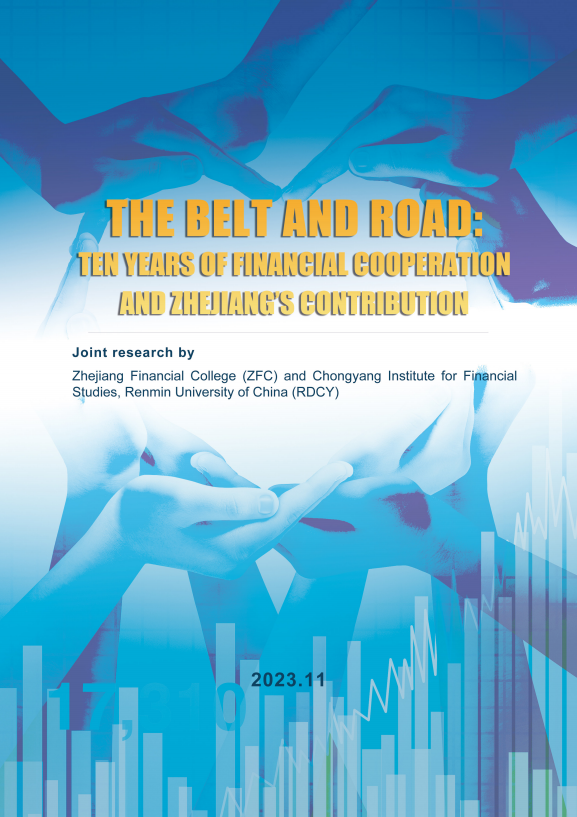Reports
Your Present Location: PUBLICATIONS> ReportsZFC x RDCY Research Paper: The Belt and Road: Ten Years of Financial Cooperation and Zhejiang's Contribution

Abstract
Financial cooperation over the past decade under the Belt and Road Initiative reflects China’s initial exploration of expanding its financial opening up and highlights China’s positive international influence in the financial sphere, but challenges still lie ahead.
According to data released by the National Development and Reform Commission, PRC, as of June 2023, China has signed more than 200 cooperation agreements for jointly building the Belt and Road with 152 countries and 32 international organizations, covering 83% of China’s diplomatic relations, with many of them encompassing financial cooperation.
Taking into account the newly added projects in the past three years, the total investment in projects under the BRI framework over the past decade has reached at least 5 trillion US dollars.
Thanks to the financial connectivity under the BRI framework, RMB has now become the fifth-largest international reserve currency and the fifth-largest payment currency. It ranks third in the International Monetary Fund’s special drawing rights basket, surpassing the British Pound and the Japanese Yen, and trailing only behind the Euro and the US Dollar.
Stocks, bonds, funds, insurance, and other forms of direct financing are increasingly becoming important funding channels for the Belt and Road Initiative.
Over the past decade, a clearly structured and sizable Belt and Road financial cooperation network has taken shape. This financial cooperation network sets itself apart from traditional multilateral financial institutions like the World Bank. While each component of this network has its own focus, they complement each other, and are gradually addressing long-standing challenges such as insufficient infrastructure investment funds, underdeveloped financial markets, low degree of financial openness, limited financing methods, and inadequate integration of industry and finance within the Belt and Road Initiative. More importantly, this diversified investment and financing system for jointly building the Belt and Road has been imbued with the Chinese concepts of mutual benefit and win-win results from the very beginning.
Ten years of financial cooperation under the Belt and Road Initiative is giving rise to a high-quality financial support system characterized by “joint participation, enhanced effectiveness, solidified services, innovative models, and risk prevention”. This system continues to foster consensus among nations, mobilize more financial institutions to participate, expand the scale of financial provision, and strives to address the financing obstacles in global development and bridge the gaps in the existing international financial system.
In the future, China should further strengthen financial security cooperation with governments and financial institutions of participating countries of the Belt and Road Initiative in areas such as talent, funds, management, risk control, and data. This includes exploring the establishment of an international joint credit guarantee model, enhancing risk prevention and control in financing and operations, ensuring the sustainable operation of the Belt and Road projects, and continuously achieving new successes in promoting high-quality Belt and Road cooperation.
Financial cooperation over the past decade under the Belt and Road Initiative reflects China’s initial exploration of expanding its financial opening-up and underscores China’s positive international influence in the financial sector. The road ahead remains challenging but promising.
The Belt and Road, with the “Five Connectivity” as the main content, has evolved over the past decade from an initiative to practical implementation. It has shifted from a proposal by one nation to international recognition, achieving numerous significant breakthroughs in Chinese-foreign cooperation. It has become the world’s largest, most inclusive, and most beneficial global public good.
Compared to policy coordination, connectivity of infrastructure, unimpeded trade, and strengthened people-to-people ties, financial integration seems to be less visible to public opinion. However, it has made significant contributions to promoting high-quality Belt and Road cooperation through multi-level and diversified financial platforms involving product innovation, industrial Finance integration, debt-equity combination, green and low-carbon initiatives, and inclusive development. It also supports and safeguards the advancement of the other four aspects in Five-Pronged Approach.
In this regard, the author has provided a systematic overview of financial cooperation under the Belt and Road Initiative in the past decade and proposed effective practices in the joint pursuit of highquality Belt and Road financial cooperation.
Key Words: Financial Cooperation, Zhejiang, BRI























































































 京公网安备 11010802037854号
京公网安备 11010802037854号





